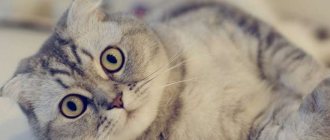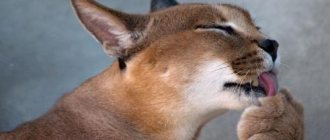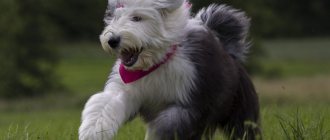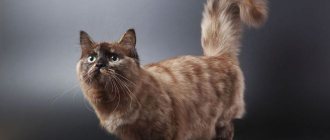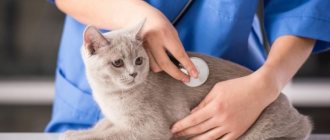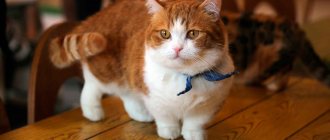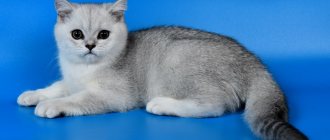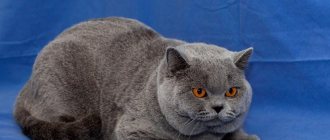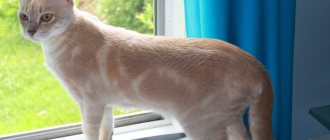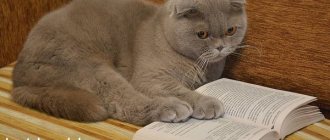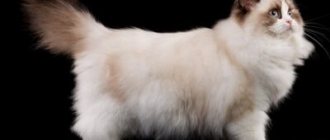The Scottish Fold, which is the name of the world's favorite breed of Scottish Fold cats, is distinguished by such a cute and charming appearance that these animals with their ears turned forward and down are often compared to plush toys. But few people know that these cats owe their doll-like appearance to a rare and rather dangerous gene mutation, the negative manifestations of which breeders encountered when attempting their first breeding.
Scottish fold cat.
Content
- History of the breed
- Description of the straight-eared Scottish cat Breed standard
- Rock defects
- Distinctive features
- Use of ready-made feed
History of the breed
In 1961, a cat named Susie was born on a Scottish farm. She had long white hair and small drooping ears.
The unusual representative of the cat family interested local breeders, and they set about breeding a new breed called the Scottish Fold.
However, when crossing two individuals of the same type, cubs with congenital pathology of the musculoskeletal system appeared.
The English organization of felinologists introduced a ban on breeding the breed. But already in the 70s. selection was continued by American geneticists.
During the work, it turned out that lop ears are not inherited by all cats, and the birth of healthy offspring is possible only by mating individuals with different types of ears.
Within the Scottish breed, 4 varieties have formed:
- long-haired fold - highland fold;
- straight-eared longhair - Highland Straight;
- fold-eared shorthair - Scottish fold;
- straight-eared shorthair - Scottish Straight.
The appearance of all representatives is characterized by a smooth, rounded silhouette and a variety of colors.
Colors
Felinologists identify the basic colors of the Scottish Straight cat:
- black;
- blue;
- chocolate;
- lilac;
- cinnamon (milk chocolate);
- fawn (light cinnamon);
- cream;
- red.
The main background may contain various patterns: brindle, spotted, marble. In addition, there are variations with white colors: medallion, bicolor, harlequin, van, exclusively white. Cats of colors with silver look great: smoky or silver drawn, shaded, chinchilla.
There are a group of golden colors: ticked, shaded, golden chinchilla. There are also straight point colors with all sorts of variations in shades and patterns.
The group of tortoiseshell Scots is not inferior in number. Often there are cats of patchwork, solid, painted colors, as well as calico.
Plain (solid)
Solid colors are characterized by monotony. There are no patterns, markings or ticking on the coat.
Varieties:
- Dazzling white. The iris is amber, blue. The nose and paw pads are pink.
- Pure black. The iris is amber, the nose and paws are dark, blending in with the fur.
- Blue with dark gray edge. Amber iris. The nose and paws are gray.
- Lilac - the coat is light gray, transitioning to cream. Amber iris. The nose and paws match the color.
- Red with a fiery edge. The iris is amber, the nose and paws are the same color as the fur.
- Cream - light peach colored coat. The iris is golden. The nose and paw pads are pink.
- Cinnamon is a cinnamon color, reminiscent of milk chocolate. The nose and paw pads are pink-brown.
Bicolors (two-color)
Varieties:
- Bicolor is a combination of basic white with blue, black, cream, and red. The muzzle, belly, legs and thighs are light, without inclusions. Eyes are golden or blue. Heterochromia - different colored eyes - is also common.
- Van - the main color is white, but there are dark markings on the tail and head. The iris is golden or blue. Heterochromia is characteristic.
- Harlequin has a white edge and only 1/5 of the fur is colored.
Color point
There are no patterns on the body, which is why it contrasts with dark blotches on the muzzle, paws and tail.
Varieties:
- blue point (white with light blue);
- seal point (cream with dark brown);
- lilac point (white with lilac);
- Choclet point (white with brown);
- cream point (light cream with cream);
- tortoiseshell with red or cream spots;
- tabby point (striped pattern).
Reference. Pointed cats are born with a gene that causes hairs on parts of the body such as the face, paws, tail and ears to darken when body temperature is low. In these places there is weaker blood circulation, which is why the color is darker.
Scots have a color-point sky blue iris.
Tortoiseshells
There are fire and peach markings on a mostly black background. The iris is copper. The nose and paws are pink or black.
Smoky
Representatives of the smoky color have a white undercoat. The iris is golden.
Varieties:
- Black. The tips of the hairs are black, the bulbs are white. The nose and pads match the color.
- Blue. White undercoat, edge with a coolish gray coating. The nose and paws are in the same color scheme.
- Cameo. Snow-white undercoat, guard hairs with a fiery tint. The nose, paws and eyeliner are pink.
Tabby
Representatives of the tabby breed have a distinctive feature - a mark on the forehead in the shape of the letter M. There are narrow stripes on the tail and limbs, smoothly turning into marble patterns and narrow stripes on the neck and body of the animal. The drawing is bright and contrasting. The eyes and nose are lined dark.
Varieties:
- Striped or brindle - a clear pattern of narrow stripes. There is a pattern on the neck in the form of a collar, the tail is striped. There are stripes across the body, along the back line, in the withers area, which are combined into a pattern reminiscent of a saddle.
- Spotted tabby - marks of different shapes and sizes with clear contours are visible on the body. Along the spine, the spots merge into a line that stretches from head to tail. The belly is painted with small spots.
- Classic tabby or marbled - the body is covered with irregularly shaped patterns of various colors, reminiscent of stains on marble.
- Fire tabby (fawn or red) - a bright red, clear pattern of spots and stripes on a light background is visible on the body. The eyes are golden, the nose is pink-orange, and the paw pads are brick-colored.
- Blue tabby - a clear pattern of dark spots and stripes is visible on a cool gray background. The iris is golden or sky blue. The nose and paw pads are pink.
- Brown tabby - black patterns on a beige background. The eyes and nose are dark in color, the pads are dark beige, almost black.
- Cream tabby - dark, slightly blurry patterns of streaks and stripes are visible on a light peach coat. The eyes are golden, the nose and paw pads are pink.
- Silver tabby - on a silver background you can see a black pattern of stripes turning into spots. The iris is light beige or green. The nose is pink-beige, the pads are dark.
Chinchilla
Varieties:
- Silver - white undercoat, guard hairs covered with gray. There may be blurry stripes on the tail. The tips of the ears, chin and belly are white. The iris is green, the nose is beige. The eyes, nose and lips are lined in black. The paw pads are also black.
- Red or Shell Cameo - snow-white undercoat, the fur on the body and paws is tucked in red, the chin, tips of the ears and belly are white. The iris is golden, the nose is brick-colored, and the paw pads are pink.
ticked
Ticking cats have hairs that are unevenly colored in three colors. On each hair, zones of different colors alternate across in the form of rings without traces of a pattern. This way unique shades are created. It seems that the wool shimmers in different colors. The iris is of all shades of gold; in cats with silver ticking it is green.
Shaded
Such cats have an almost white undercoat, and the tips are whitish. The edge is trimmed in any color, the chin and belly are always light.
Varieties:
- Golden - Light peach goes well with golden fur. The iris is green, the paw pads and nose are dark chocolate.
- Silver - snow-white undercoat, the tips of the hairs are dark gray. The eyes are green and lined with black. The nose is brick, the pads are dark.
- Red or cameo - the undercoat is white, the tips of the hairs are dark red. The muzzle and chin, belly and underside of the tail are light. Amber iris. The nose, eyeliner and paw pads are pink.
Description of the straight-eared Scottish cat
Despite the similarities with British individuals, the Scots have a number of differences. They are smaller in size, graceful in shape and have a more rounded skull.
Breed standard
Table - Basic requirements for the exterior
| Part of the body | Description |
| Head | Round, massive, with full cheeks and a high, prominent forehead |
| Neck | Thick, short |
| Muzzle | Rounded, with pronounced whisker pads and a well-developed chin |
| Nose | Short (or medium), wide, the transition line from the forehead with a slight depression |
| Eyes | Round, widely spaced, usually amber or green in color |
| Ears | Small to medium sized, erect, with rounded tips, set wide apart |
| Frame | Medium to large size, with smooth lines |
| Limbs | Proportional to the body, with rounded paws |
| Tail | Medium or long, tapering towards the end |
The coat is soft, non-adherent, with a developed undercoat. In Scottish Straight individuals it is shorter and plush, in Highland cats it is long and silky.
Color – any color found in representatives of the breed. The most common types:
- plain;
- bicolor;
- point;
- tabby;
- particolor;
- chinchilla;
- ticked;
- van;
- shedded.
The average weight of a straight-eared Scottish cat is 3–3.5 kg.
Rock defects
External disadvantages are considered:
- semi-erect or too wide ears with a “British” fit;
- flat forehead;
- pronounced stop;
- small eyes;
- long limbs.
Disqualifying faults include:
- the tail is not long enough, inactive, and has kinks;
- twisted fingers;
- cryptorchidism (undescended testicle).
Weak and sick individuals are not allowed to participate in exhibitions.
Standard
There are quite strict standards for appearance. According to the standard, the head should be round, the muzzle should be rounded, have a strong chin and jaw inherited from the British Shorthair, as well as medium-sized ears.
The eyes should be separated by a wide short nose and have a color that matches the body color. The coat must be plush, short, and quite dense.
The limbs of Scottish Fold cats are of medium thickness and length, moderately muscular and strong.
Character and behavior
Scottish Straight cats have a balanced temperament, developed intelligence and aristocratic manners.
Distinctive features
Straights by their nature:
- calm;
- modest;
- independent;
- curious;
- friendly;
- affectionate;
- playful.
They become attached to one person, although they are good-natured towards all family members. These cats cannot be called tame - for them it is preferable to sit next to the owner than on his lap.
They behave unobtrusively, without requiring increased attention and affection. They love both quiet time and active games.
Straight-eared Scots are indifferent to heights: they are unlikely to climb curtains and cabinets. However, straights show great interest in surrounding objects. For this reason, fragile items should not be in their field of vision.
Communication with people and animals
These cats feel comfortable both in familiar company and alone.
Scottish straights:
- They are friends with children: they participate in games, tolerate mischief, without showing aggression.
- They get along well with other cats and dogs. But small rodents and birds can become objects of hunting for the strite.
- They treat strangers with restraint: they do not show excessive suspicion, but they also do not want to make contact.
- They tolerate loneliness calmly, so they are suitable for owners who are very busy and often absent from home.
- They easily accept moving to another place of residence.
Scottish Straight cats are laconic: contented purring and annoying “meow” can be heard only in exceptional cases.
Owner reviews
Below are reviews from two cat owner buyers. The first author, Zhanna, purchased a Scottish fold kitten from a nursery, the second author, Nikolai, adopted the kitten through an ad on Avito.
Zhanna, 28 years old: “Having a kitten was my childhood dream. When I was little, my parents had no time for it - Perestroika, unemployment... But now I was finally able to fulfill my dream. My husband and I came across Scottish Folds by accident - we were googling funny breeds and saw them. Oh, these eyes, these ears... We immediately found nurseries of these cats in Moscow, compared prices, came to the nursery... The girl who was offered to us, she was... chocolate! Like a teddy bear! We bought it. Yesterday we were at the exhibition with her...”
Nikolay, 32 years old: “We found a kitten through an advertisement, and for some reason we didn’t wonder why a housewife from Nerekhta had a dozen “purebred” Scottish Folds at home. But okay, the pedigree, to hell with it. Natalya swore that the kittens were healthy, but Ambassador began to get sick soon after moving to us. Let's go to the veterinarian... In short, Natalya sold us a defective cat, and that entire litter was defective. It’s a pity, we paid, of course, less than what we would have had to pay to the breeder, but it’s still a pity. The kitten had to be put to sleep..."
To read: Features of the Beagle breed, reviews from owners
Buying a kitten is a big responsibility, because we are responsible for those we have tamed. However, buying a Scottish Fold is not only a responsibility, but also a great happiness. A Scottish Fold kitten will become a friend to a child and a companion to an adult, and will be able to console or cheer up at the right time.
This cute creature will certainly bring happiness to every home!
Maintenance and care
From the first days of life in a new home, your pet will need a regular cat kit:
- bowls;
- bed;
- litter tray.
Straight care includes several types of procedures:
- Bathing. The event is carried out once every 6 months or as the coat becomes dirty, using a special shampoo. Representatives of this breed are not afraid of water and take the procedure calmly.
- Combing. Manipulation is recommended to be carried out weekly: for Scottish - once, for Highland - 2-3 times every 7 days. During shedding, it is advisable to brush your cat every day.
- Ear cleaning. Done once a week. Gently wipe the inside of the ears with a damp swab.
- Eye wash. The procedure is carried out in a similar way when there is an accumulation of discharge.
- Dental care. In order to prevent caries and the formation of stones, it is recommended to clean them once a week using a brush and paste for cats.
- Trimming nails. Produced as needed. If the cat uses a scratching post, the event may not be held.
When preparing for exhibitions, more careful care of the coat is required using professional cosmetics.
How much does it cost and where to buy
The cost depends on what category the Scottish kittens belong to. If you just choose a beautiful pet, the price may be less than 10 thousand rubles.
If a kitten with a rich pedigree meets breed standards and can participate in exhibitions, the price will increase to 50 thousand rubles.
You should only buy from trusted places, preferably from a nursery. Experienced breeders will help you choose the right kitten according to your wishes.
How to distinguish from an ordinary cat
You can easily distinguish a Scotsman from an ordinary cat after he reaches 3-6 months. By this time, all the signs of the breed appear and it is easier to determine whether the cat you are being offered is purebred.
It is better to trust a professional, he will be able to distinguish earlier. The Scottish cat has the main distinctive features: the structure of the body and paws, the shape of the muzzle and the structure of the coat.
Feeding
Straight-eared Scots have an excellent appetite and easily gain extra pounds. It is advisable to take this feature into account when preparing a cat’s diet.
Use of ready-made feed
Many breeders recommend this option because the factory product:
- has a balanced composition;
- stores well and for a long time;
- Suitable for time-saving owners.
With this type of feeding, you should use a premium or super-premium diet.
Natural menu
The Scots like dishes made from ordinary products no less than processed foods.
What should be included in the diet
The basis of the cat menu is:
- lean meat - veal, turkey, chicken;
- sea fish (once a week);
- chicken yolk, quail egg (once a week);
- porridge – oatmeal, rice, buckwheat;
- vegetables - cauliflower, carrots, zucchini, pumpkin;
- greens – parsley, dill;
- fermented milk products – low-fat cottage cheese, kefir.
Meat, fish, vegetables are boiled or steamed.
Prohibited Products
Like other domestic cats, Scots should not be offered:
- fat meat;
- bones;
- river fish;
- raw eggs;
- whole milk;
- potatoes, legumes;
- citrus;
- mushrooms;
- flour products;
- sweets.
It is necessary to completely eliminate spicy, salty, fried and smoked foods.
Diet
The number of meals depends on the stage of development of the cat:
| Pet's age/month. | Number of feedings per day |
| 3 | 6 |
| 6 | 5 |
| 9 | 4 |
| 12 | 2-3 |
It is enough for an adult to eat 2 times a day.
Vitamin and mineral supplements
With a natural type of feeding, an insufficient amount of necessary substances may enter the animal’s body. To prevent such deficiency, it is recommended to use vitamin and mineral complexes.
If the cat eats high-quality industrial food, supplements should not be administered.
Raising a Scottish Straight
Thanks to their innate intelligence, Scots quickly learn the rules of good manners. To get positive results it is recommended:
- Start training from the first days the pet appears in the house.
- Establish a friendly relationship with affection and treats.
- When a child tries to commit an inappropriate act, warn with a loud “No!” For greater effect, the shout is accompanied by clapping your hands.
- If the ward does not respond to strict intonation, take him by the withers and lightly shake him several times.
- Reward each pet's achievement with generous praise and treats.
Do not do it:
- Punish the young straight for excessive activity. When the baby grows up, the problem will solve itself.
- Raising a kitten with a slap and poking its muzzle into a puddle. The consequence of such techniques may be the opposite result.
- Scolding and praising the Scottish Straight retroactively. Animals are not able to establish logical connections between events on different days.
Scots are quite trainable if they want to. A playful form of exercise and your favorite treats will help you achieve good results.
Characteristics of the Scots
Cats of this breed are very attached to humans, they learn quickly and are even trainable. The cat purrs rather strangely. The animal makes creaking, quiet sounds. But you won't hear your pet's voice very often. The Scots don't like to talk about trifles.
Animals of this breed often sleep on their backs, stretched out to their full height, and this sight always brings a smile of affection. The ability to stand on its hind legs is another feature of the breed.
Health and life expectancy
Unlike folds, straight-eared Scottish cats do not suffer from genetic diseases. However, they are susceptible to such violations as:
- arthritis, arthrosis;
- inflammation of the genitourinary system;
- diseases of the digestive tract.
To avoid health problems, you must:
- Vaccinate the animal from two months of age.
- Conduct anthelmintic prophylaxis in a timely manner.
- Provide the Straight with a nutritious, healthy diet.
With proper feeding and care, Scots live 15–20 years.
Breeding
Sexual maturity in straight-eared representatives occurs at 8–10 months, however, the minimum age for the first mating of Scottish Straights is 1 year and 3 months (the optimal period for conception is the second or third heat).
To avoid genetic disorders, mating of a Fold cat is carried out exclusively with a Straight cat, and for a fold-eared male, a straight-eared female is selected!
Pregnancy in Scottish women lasts 60–65 days. During the first three weeks, toxicosis may occur. At the end of this period, the expectant mother's appetite improves and she gains weight.
A pregnant cat becomes less active and shows increased caution. Restless behavior appears shortly before birth.
Usually in one litter of a Scottish female there are 4 cubs, but there are exceptions when a Scottish female gives birth to up to 8 kittens at a time. Multiple births are inherited through the maternal line.
Sterilization and castration
If breeding is not planned, it is recommended to castrate or sterilize the animal. This tactic:
- Helps you avoid health problems.
- It will have a positive effect on the pet’s character.
- Will increase life expectancy.
It is recommended to operate on a cat after puberty (8–10 months). If necessary, a female who has given birth can also be sterilized. Both male cats and female cats tolerate surgery normally at any age.
Pros and cons of the breed
The ratio of positive and negative characteristics of the Scottish Straight is as follows:
| Advantages | Flaws |
| Flexible character | Periodic manifestations of obstinacy |
| Loyalty to the owner | Excessive independence |
| Child friendly | Reluctance to be held |
| Get along with other pets | Desire to hunt birds and small rodents |
| Easy to learn | In some cases - reluctance to succumb to training |
| Adaptability | Increased appetite |
| No genetic disorders | Tendency to excess weight and a number of diseases |
This classification is conditional and differentiates the general characteristics of the breed. Animals, like people, can express themselves in different ways, depending on individual heredity and upbringing.
How to choose a kitten
So, the pros won over the cons, and you decided to buy a small Highland.
To ensure that a friendly purebred pet settles in your home, choose your kitten responsibly.
There are three main criteria according to which it is recommended to select a pet:
- Appearance . All kittens are beautiful in their own way. However, if you are going to take your pet to shows, make sure that its exterior meets the standard. If you are not looking for a show star, but an ordinary favorite, then appearance in this case will only play a touching role.
- Temperament . A much more important criterion than appearance. Get to know the kittens better. Take a closer look at which of them shows the greatest interest in the stranger, who is most willing to be picked up and join the game. Socialization is extremely important and it manifests itself at a very early age. A kid who hides in a corner will most likely grow up to be an independent loner. Choose a kitten that responds at the first call.
- Health . The easiest way to judge a kitten's health is by its coat. A healthy baby's fur is shiny and crumbly. Also pay attention to the tail. It should be flexible along its entire length, without creases or deformations. There should be no traces of discharge around the animal’s eyes and nose, and the baby should smell like milk. A bloated tummy and bad breath indicate illness.
Ask the breeders what vaccinations the kitten was given, and also consult about the baby’s favorite food.
